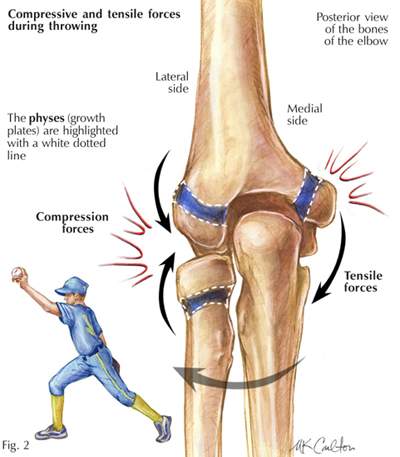
As spring approaches, so does the start of baseball season. This means a lot of throwing activities and also means many young players (ages 8-15) developing elbow pain. “Little Leaguer’s Elbow” aka medial epicondyle apophysitis is a common overuse injury associated with overhead throwing. It should be noted that other young athletes who play volleyball, tennis, and football (quarterback) can also develop this condition. Little Leaguer’s elbow is the result of repetitive stress/strain to the growth plate on the inner part of the elbow known as the medial epicondyle. With frequent overhead throwing, the growth plate can become very irritated and inflamed. Symptoms typically include pain (achy, sharp), tenderness, swelling, and stiffness along the inside of the elbow. Pain is usually worse when trying to throw the ball hard or far. Early detection is important and you should consult a doctor right away when symptoms occur.
The treatment for Little Leaguer’s elbow is usually conservative and consists of rest, proper rehabilitation, and gradual return to throwing. The resting period means avoiding ALL throwing activities for a period of at least 4-6 weeks, but may be much longer depending on the severity of the condition. Applying cold packs and taking NSAIDs may also be recommended. During the resting phase, a rehab program or physical therapy can help to improve range of motion, flexibility, strength, stability, and endurance to prepare for return to throwing. Only after sufficient rest and when the athlete is completely pain-free, can a structured, progressive return to throwing program be initiated. Any pain symptoms developed during the return to throwing program means additional resting time until the symptoms fully resolve.
Parents and coaches can be active in reducing the incidence of Little Leaguer’s elbow by taking these steps:
- Adhere to all pitch count guidelines.
- Avoiding breaking pitches (eg – curveball, slider) until growth plates have closed.
- Pitchers should not participate in more than one league during overlapping seasons.
- Teach proper throwing/pitching mechanics.
- Maintain optimal fitness including flexibility, strength, and stability.
If you have any questions, contact our team at ProActive Physical Therapy & Sports Medicine.

